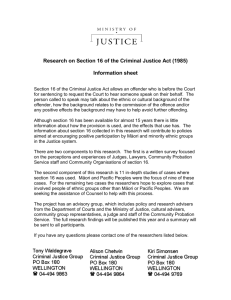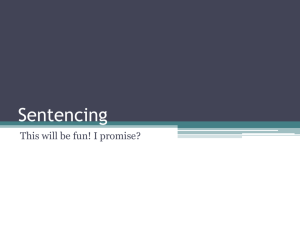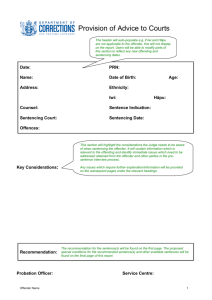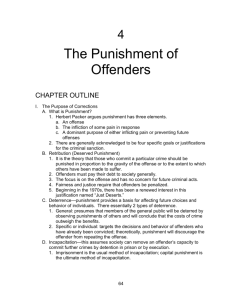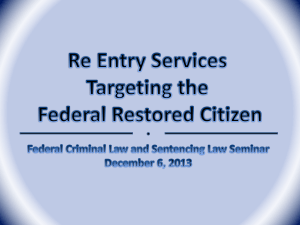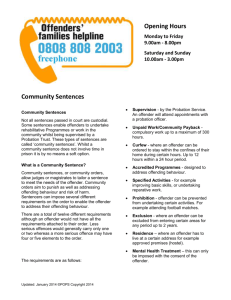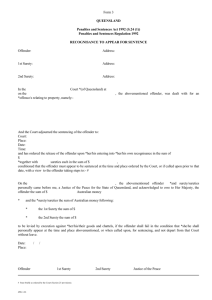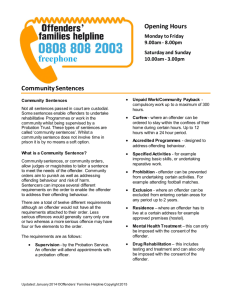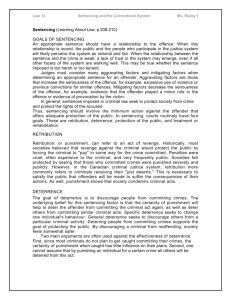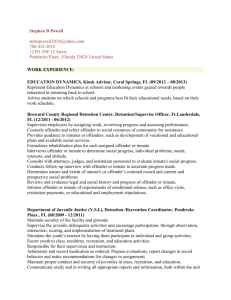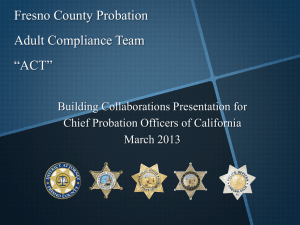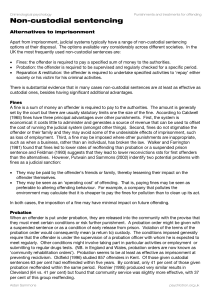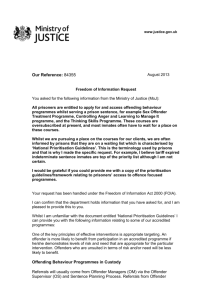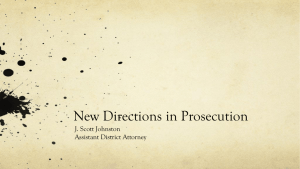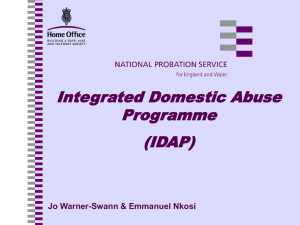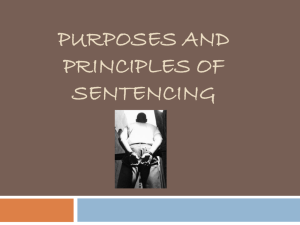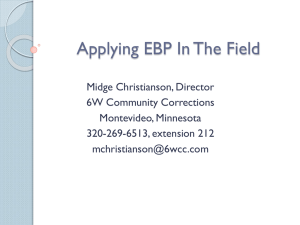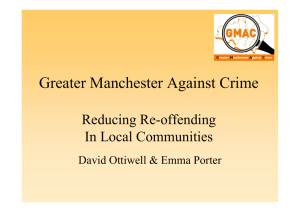Suspended Fine Program Description - Resources
advertisement
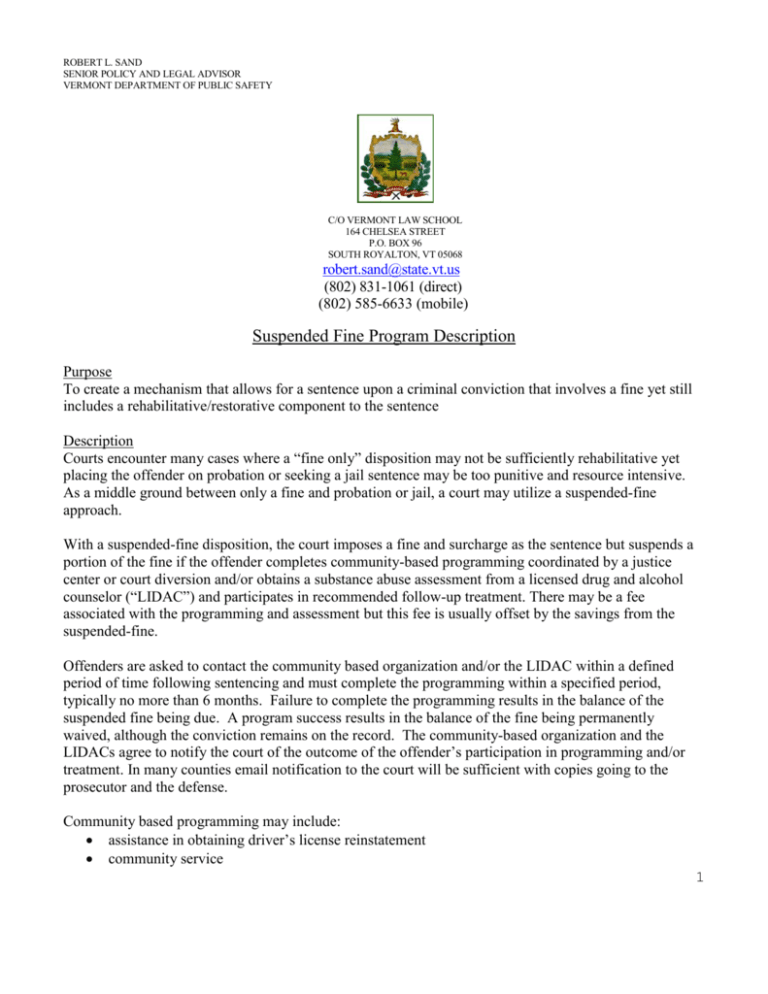
ROBERT L. SAND SENIOR POLICY AND LEGAL ADVISOR VERMONT DEPARTMENT OF PUBLIC SAFETY C/O VERMONT LAW SCHOOL 164 CHELSEA STREET P.O. BOX 96 SOUTH ROYALTON, VT 05068 robert.sand@state.vt.us (802) 831-1061 (direct) (802) 585-6633 (mobile) Suspended Fine Program Description Purpose To create a mechanism that allows for a sentence upon a criminal conviction that involves a fine yet still includes a rehabilitative/restorative component to the sentence Description Courts encounter many cases where a “fine only” disposition may not be sufficiently rehabilitative yet placing the offender on probation or seeking a jail sentence may be too punitive and resource intensive. As a middle ground between only a fine and probation or jail, a court may utilize a suspended-fine approach. With a suspended-fine disposition, the court imposes a fine and surcharge as the sentence but suspends a portion of the fine if the offender completes community-based programming coordinated by a justice center or court diversion and/or obtains a substance abuse assessment from a licensed drug and alcohol counselor (“LIDAC”) and participates in recommended follow-up treatment. There may be a fee associated with the programming and assessment but this fee is usually offset by the savings from the suspended-fine. Offenders are asked to contact the community based organization and/or the LIDAC within a defined period of time following sentencing and must complete the programming within a specified period, typically no more than 6 months. Failure to complete the programming results in the balance of the suspended fine being due. A program success results in the balance of the fine being permanently waived, although the conviction remains on the record. The community-based organization and the LIDACs agree to notify the court of the outcome of the offender’s participation in programming and/or treatment. In many counties email notification to the court will be sufficient with copies going to the prosecutor and the defense. Community based programming may include: assistance in obtaining driver’s license reinstatement community service 1 help with housing, employment, transportation completion of a life skills inventory to help the offender gain better insight into risk areas referral to a reparative board and completion of a reparative contract The beauty of the program is that even in cases for which jail or probation is not a necessary outcome, the sentence can still include a rehabilitative component and can help connect the offender with his or her community. Additionally, in those instances where the programming is not completed in time or the offender declines to participate there is no need for additional judge time as the lone consequence is that the offender owes the balance of the original fine. Driving offenses are particularly well suited to the suspended fine approach, although other cases may work as well. A fairly important consideration is whether the offense provides an adequate statutory maximum fine to create enough of a financial incentive to participate in programing. First offense low test DUI cases as well as negligent and grossly negligent operation and driving with a suspended license offenses have all worked well using this approach. Moreover, DUI’s low test first offenses that are reduced to negligent operation or grossly negligent operation are particularly well suited as the fine amounts are greater for the 23 VSA 1091 violations than they are for the 23 VSA 1201 violations. Example Attached to this program description is a sample plea agreement for the charge of Grossly Negligent Operation (“GNO”). Here, the offender is convicted of GNO and the court imposes a $3,000 fine and corresponding surcharges. However, the court suspends $2,500 of the fine, affording the defendant six months to complete restorative justice programming through a justice center and to contact a LIDAC and participate in recommended follow-up counseling for six months. Upon sentencing under this agreement, the court clerk enters a reminder in the calendar for a date six months following sentencing. If the court receives notification of program completion, that court clerk deletes the calendar item and strikes the balance of the fine. If no notice of program completion is received by the court at the expiration of the six-month period, the court clerk indicates that the balance of the fine is owed and the normal collection process follows. It is true that this process involves some additionally calendaring by court staff but since these outcomes do not require probation warrants and do not result in violation of probation hearings there is a net reduction in court clerk and judge time as compared to a probationary outcome. Program Requirements A suspended fine program requires no legislative changes (although a proposal has been submitted to the legislature for its approval anyway). Instead it simply requires support of the State’s Attorney, the presiding judge, the defense bar, the court staff, and community providers. Although cases in which a “fine only” is the original plea offer do not result ordinarily in the assignment of a public defender, defense counsel support of the program will allow the program to develop more rapidly. Moreover, a suspended fine program creates an additional sentencing option that may help the parties reach a case resolution. 2

